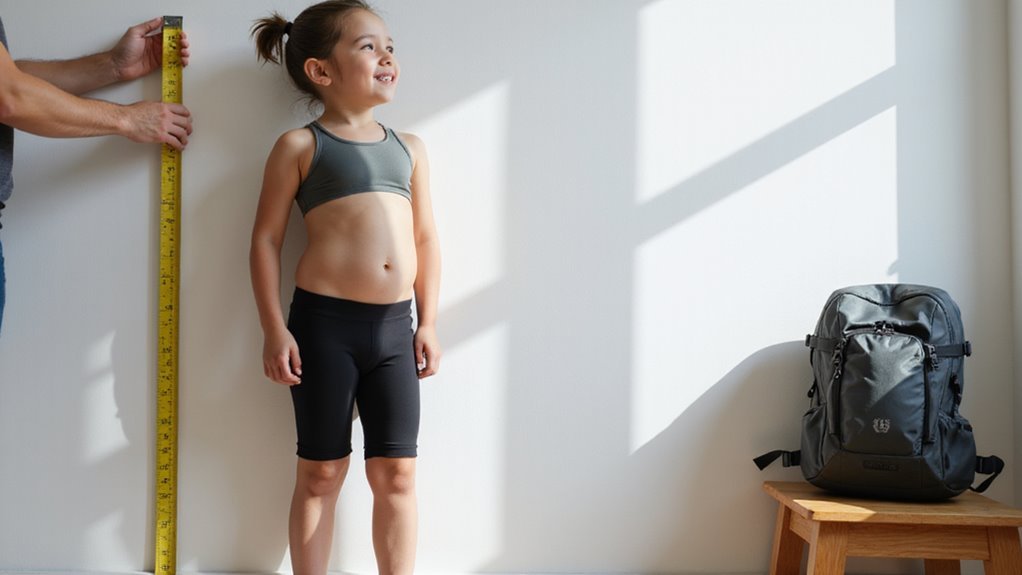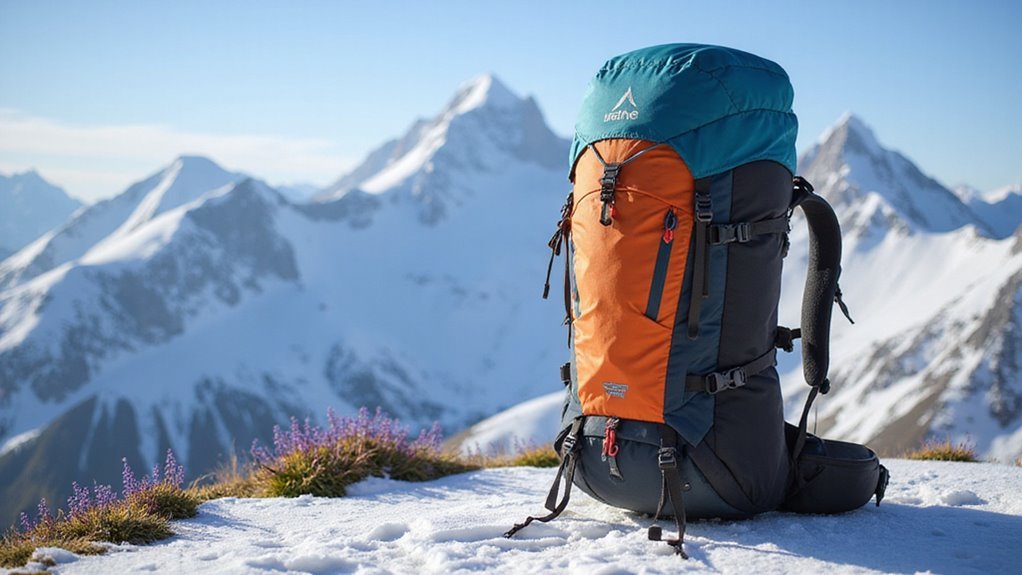Whether we’re scaling mountain peaks, traversing desert plains, or steering through dense rainforests, we’ve got to nail our backpack sizing. Let’s cut through the confusion about pack volumes and terrain-specific requirements. We’ll break down the precise measurements, load distributions, and adaptability features you need – because there’s nothing worse than realizing you’re stuck with the wrong size pack halfway through your adventure. What works for one environment might fail spectacularly in another.
Understanding Torso Length and Hip Measurements

How do you guarantee your backpack fits like it’s custom-made for your body? Let’s nail down the two critical measurements that’ll make or break your comfort on the trail.
First, measure your torso length from the C7 vertebra (that bump at your neck’s base) to your iliac crest. This determines your backpack size: small (under 16″), medium (16-19″), or large (over 19″). Get this wrong, and you’ll feel every miserable mile. Additionally, ensure your backpack’s weight is between 10-20% of body weight, as this is crucial for comfort and mobility.
Next, your hip measurements matter – big time. Your hip belt needs to sit right on the iliac crest, carrying 80% of your pack’s weight. No gaps allowed.
Once you’ve locked in that perfect hip fit, adjust those shoulder straps to keep the pack snug against your back. Trust us – proper weight distribution is the difference between crushing miles and being crushed by them.
Desert and Arid Terrain Pack Requirements
When you’re tackling desert and arid terrain, your pack’s capacity needs to hit that sweet spot of 30-50 liters – enough space for the essentials without weighing you down in the relentless heat.
We’re talking about smart packing here: at least 3 liters of water storage per day is non-negotiable. Remember that purification methods are essential for ensuring safe drinking water, especially in remote areas.
Let’s get real about materials – your backpack needs lightweight, breathable construction with proper ventilation.
Look for those suspended mesh back panels; they’re life-savers when you’re baking under the sun.
Don’t skimp on essential gear like sun protection and extra layers for those deceiving temperature drops at night.
Mountain and Alpine Pack Configurations

Unlike desert packs, mountain and alpine backpacks demand serious volume – we’re talking 50-70 liters of carefully engineered space. Internal frame structures deliver stability and weight distribution you’ll need for those brutal ascents. We’ve got ventilation systems with suspended mesh that’ll keep your back dry at 14,000 feet. Many of these packs are designed with weather protection features to withstand challenging conditions.
| Feature | Purpose | Benefit |
|---|---|---|
| Gear Loops | Tool attachment | Quick access |
| Sleeping Bag Compartment | Organization | Protected storage |
| External Frame Option | Bulky gear carry | Versatility |
Let’s talk ultralight options – they’re perfect when you’re pushing limits in alpine conditions. These stripped-down packs maintain essential features while cutting pack weight. You’ll still get those reinforced gear loops and tool attachments, just without the excess. Trust us, every ounce counts when you’re scaling that north face.
Rainforest and Humid Climate Pack Selections
Maneuvering dense rainforest terrain demands a pack that’s ready for both sweat and sudden downpours.
We’ll need a 30-50 liter capacity – enough room for those essential hydration supplies and lightweight clothing without turning you into a sweaty mess.
Let’s get serious about ventilation features.
We’re talking mesh back panels that’ll keep air flowing during those humid hikes. Your pack needs waterproof materials because, trust us, you’ll hit rain.
Smart organization is non-negotiable – hipbelt pockets keep snacks within reach while you’re pushing through dense foliage.
Don’t skip the removable rain cover. It’s your last line of defense when the sky opens up, which it will. Additionally, ensure your pack includes integrated rain covers for convenient and effective weather protection during unexpected downpours.
Multi-Terrain Backpack Adjustments and Features

Because your backpack’s going to face everything from rocky summits to muddy valleys, you’ll need a Swiss-Army-knife approach to adjustability.
We’re talking adjustable suspension systems that’ll match your torso length perfectly, while load-lifter straps keep everything snug against your back.
Let’s tackle sweat – those suspended mesh back panels and ventilation features aren’t just fancy terms. They’re your best defense against turning into a human sprinkler system.
You’ll want both top-loading and panel access because fumbling for gear mid-adventure isn’t anyone’s idea of fun.
And don’t overlook those specialized attachment points – daisy chains and gear loops are your ticket to securing everything from ice axes to trekking poles.
Trust us, on multi-terrain adventures, adaptability isn’t optional – it’s essential. Additionally, make sure to master weight distribution techniques to enhance comfort and stability during your journey.
Pack Volume Optimization for Mixed Landscapes
When tackling mixed landscapes, your pack volume needs surgical precision – not guesswork.
We’re looking at 30-50 liters for weekend warriors, while multiday adventures demand 50-70 liters to handle diverse conditions. There’s no room for error here.
Let’s get practical: pack volume optimization isn’t just about size – it’s about smart weight distribution. When selecting your pack, remember to measure torso length to ensure a proper fit.
We’re fans of ultralight options under 50 liters for those technical trails where every ounce counts. But don’t get cocky – seasonal variations will throw you a curveball.
Winter? You’ll need 70+ liters for all that bulky clothing.
Frequently Asked Questions
How Do I Know What Size Backpack to Get?
We’ll measure your torso length and assess your trip needs. Consider backpack weight, load distribution, and adjustable straps. Choose a size that matches your activity’s duration and gear requirements.
What Size Backpack for Multi-Day Hikes?
We recommend 50-70 liter packs for multi-day hikes, allowing space for packing essentials, clothing layers, food storage, and emergency supplies. Consider 70+ liters for winter trips with extra gear organization needs.
Is a 55L Backpack Big Enough for Backpacking?
Like Goldilocks finding her perfect fit, we’d say a 55L capacity is ideal for 3-5 day trips when you master packing techniques and gear organization. It’s versatile across suitable terrains with proper weight distribution.
What Size Backpack for Backcountry?
We recommend a 50-70 liter pack for backcountry essentials, allowing space for gear organization, safety equipment, cooking gear, and clothing layers while maintaining proper weight distribution across challenging terrain.